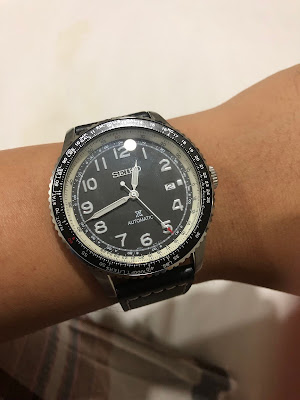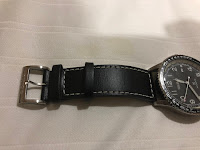 During Baselworld 2017 in March 2017, Seiko launched a number of new series. However, the focus of watch lovers was squarely on the SLA017J1, a reissue of the famous 62MAS dive watch. This was unfortunate as there are a number of gems launched by Seiko during that time that should have been given the light of day. The Seiko Prospex Sky Slide Rule Bezel Navitimer series is one of them.
During Baselworld 2017 in March 2017, Seiko launched a number of new series. However, the focus of watch lovers was squarely on the SLA017J1, a reissue of the famous 62MAS dive watch. This was unfortunate as there are a number of gems launched by Seiko during that time that should have been given the light of day. The Seiko Prospex Sky Slide Rule Bezel Navitimer series is one of them.It was only two years later that I was able to revisit this series in depth. Originally I was to get the bracelet version but unfortunately none of the merchants I am comfortable with have one in stock. Instead, I opted for the black dial with leather strap, the SRP61K1. I found it in one of my favourite watch shop in Mid Valley Megamall, AWG.
This watch has one unique complication, the bi-directional slide rule bezel. For those of you that like maths, this complication is so cool (I am one of them!).
The History of Slide Rule
An English mathematician, Reverend William Oughtred was the inventor of the slide rule in the 1630. It is a tool invented to help users do complicated calculations such as: multiplication, division, square root, exponential, logarithms and trigonometric functions. It is simple yet ingenious tool that consist of two scales on two surfaces that can slide against each other (hence the name).

It is widely acknowledged that the Breitling Watch Company was the first watchmaker that put slide rule on a watch back in 1952. It is because of this that the slide rule is sometimes called the rotary slide rule.
Apart from the standard mathematical scales, the rotary slide rule on an aviator watch has additional information needed to calculated aviation related calculations such as rate of climb (or descent), flight time, distance, fuel consumption as well as unit conversions.
In the modern age, the slide rule is obsolete. Not many people know how to use it let alone seen it in real life. It is relic of a bygone era before the advent of the electronic calculator.
The Casing
 The watch is made out of stainless steel. It has a diameter of 44.7 mm while its lug-to-lug is 50.0 mm. Thickness is 13.3 mm and the overall weight is approximately 89 gm. The lug width on the watch is 22 mm. The watch is contemporary in design with the crown located at 3 o'clock. A bi-directional bezel is also provided.
The watch is made out of stainless steel. It has a diameter of 44.7 mm while its lug-to-lug is 50.0 mm. Thickness is 13.3 mm and the overall weight is approximately 89 gm. The lug width on the watch is 22 mm. The watch is contemporary in design with the crown located at 3 o'clock. A bi-directional bezel is also provided.The Dial
The dial is painted black with a ring along the edge painted in beige. Although the bulk of the dial areas is generally empty, the edge of the dial is extremely busy. Due to this, for this review, I will describe the dial from the centre first.
There are only four rows of texts and logo. The brand which is applied to the dial is located on the upper quadrant. The Prospex logo, the text "AUTOMATIC" and some production codes in micro-font size are located on the bottom quadrant. All the texts and logo in bottom quadrant are painted directly on the dial with white paint.

The primary hour markers are Arabic numbering except for the 3 o'clock. For the 3 o'clock, a square marker was used. All the primary markers are applied to the dial and painted with LumiBrite paint. Part of the 3 o'clock position is the aperture for the date window which is a rectangular cut without any framing. The date wheel has a white background which helps keep some balance to the loss of the number "3" in that location.
The hands used on the SRPB61K1 is vintage syringe-style. The seconds hand is thin with an arrow at the tip and a round circle at the end. The seconds hand is painted in white paint with the tip painted in red whereas the hours and minute hands are painted in LumiBrite. Below is the illumination on the dial in the dark.

The Rotary Slide Rule & Bezel
The primary scales on the dial as well as on the bezel that makes up the rotary slide rule are logarithmic scales. As this is a pilot's watch, additional notation such as unit conversions as well as other additional information needed to calculated aviation related measurements are provided.
I honestly do not know how to use one. However, for those of you interested to know how it works, below is an instruction manual from Seiko.
Rotary Slide rule instructi... on Scribd
The bezel is rather thin with a gear-tooth edge for grip. It is bi-directional and uses friction to keep it steady. Unfortunately, due to the logarithmic scale markings, I cannot use it to track another time zone. The bezel is definitely not that useful unlike a dive bezel or any bezel with linear scale markings.
The Crown, Crystal & Case-back
The crown is located at the 3 o'clock position and uses a simple push-in/push-out system to engage the gears on the movement. At the close position, one can manually wind the movement. In the first pullout position, one can adjust the quick-set date complication. In the second pullout position, the seconds hand will stop (hacking capable) and one can adjust the time.

The crown is contemporary with a sterile top surface. One can have a good grip of the crown by virtue of the gear-tooth side surface.
The crystal that protects the dial is made of Hardlex. However, what makes it stand out (literally) is that Seiko decided to put a dome Hardlex crystal for this series. Based on my visual inspection, the edge of the crystal is just slightly above the edge of bezel. You can see the edge is beveled and the dome slowly extending further out as you move towards the center of the crystal. I don't believe Seiko put any AR coating on the crystal.

The case-back is a screw-down. It has a display window made out of a flat Hardlex crystal where one can observe the 4R35B automatic movement by Seiko. This 23 jewel movement operates at a frequency of 3 hertz and has a power reserve of approximately 40 hours.

Based on a simple accuracy test using the Toolwatch app, my example recorded an accuracy rate of +6.2 seconds per day. This is well within the stated accuracy rate of +45/-35 seconds per day by the manufacturer.

The Strap
The lugs are curved downward towards the wrist. This makes it more wearable. Unfortunately there are no pass-through drill holes for ease of access to the spring-bars.


Paired with the watch is a double-layered black leather strap with white stitching. The strap comes with two leather strap guides, one of which is fixed beside the buckle.


The leather is stiff straight out of the box. Having it double-layered makes the "softening" process longer than usual. It was so stiff that it was hard to put it through the first strap guide. I had to bypass that guide and go straight to the second strap guide to reduce the chance of tearing it off. Hopefully, after a week of wearing the watch, the leather would be more supple (🙏).
The Wearing Experience
Apart from the stiff double-layered leather strap, the watch wears well. It definitely can be use for most occasions. I tend to wear it more in the office context which is not an issue with this watch. The only sad part is that the bezel could not be use for a different function apart from calculating stuff. I have a lot of dive watches with uni-directional bezel and all the time I use the bezel to track a second timezone or as a timer. The non-linear scale on the SRPB61K1 bezel makes it difficult to track something linear like time.



Below is a video of the watch on my wrist.
The Family
The family consist of three models, differentiated by the strap and dial colour. Launched in 2017, these models are under the Sky line within the Prospex series. These are tabulated below.
 SRPB57 SRPB57MSRP: n/a |  SRPB59 SRPB59MSRP: RM1,475 |  SRPB61 SRPB61MSRP: RM1,475 |
Specifications
Caliber: 4R35B
Movement: Automatic with manual winding capacity & stop second hand function
Power: 40 hours
Accuracy: +45/-35 seconds per day
Case: Stainless steel
Dial: Black
Crystal: Curved Hardlex
Illumination: LumiBrite on hands and indexs
Strap: Black calfskin with white stitching
Water Resistance: 10 bar
Thickness: 13.3 mm
Diameter: 44.7 mm
Length: 50.0 mm
Lugs: 22.0 mm
Weight: 89 gm
Other Complications:
- Rotating calculator bezel
- Date display
Series Launch: March 2017
MSRP: USD469; RM1,475
Purchase Date: 3 September 2019
Purchase Price: RM1,019
Manufacure Date: October 2017
Serial Number: 750840
Photo Gallery


























Can you tell me what's the size of your wrist? That way I can estimate approximately how the watches would look on my wrist
ReplyDelete6.75 inch
Delete